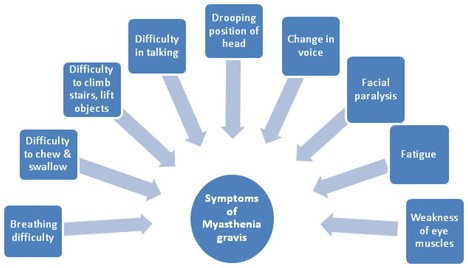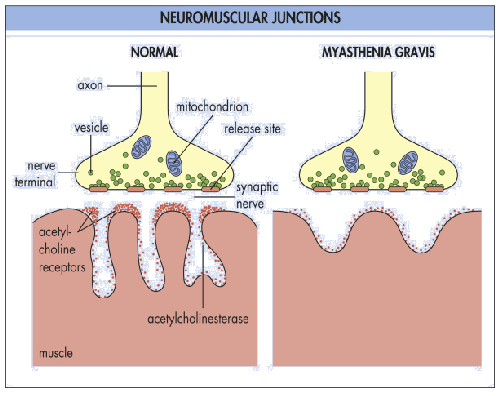Myasthenia-gravis (MG)
What is Myasthenia-Gravis(MG)?
Myasthenia Gravis (pronounced My-as-theen-ee-a Grav-us) comes from the Greek and Latin words meaning "grave muscular weakness”. Myasthenia Gravis (MG) is a neuromuscular autoimmune disease that affects the use of muscles - normal communication between the nerve and the muscle is interrupted, leaving the muscle weak and fatigued.
 The hallmark of myasthenia gravis is muscle weakness that increases during periods of activity and improves after periods of rest. Certain muscles such as those that control eye and eyelid movement, facial expression, chewing, talking, and swallowing are often, but not always, involved in the disorder. The muscles that control breathing and neck and limb movements may also be affected.
The hallmark of myasthenia gravis is muscle weakness that increases during periods of activity and improves after periods of rest. Certain muscles such as those that control eye and eyelid movement, facial expression, chewing, talking, and swallowing are often, but not always, involved in the disorder. The muscles that control breathing and neck and limb movements may also be affected.
Myasthenia Gravis occurs in all races, both genders, and at any age. MG is not thought to be directly inherited nor is it contagious. It does occasionally occur in more than one member of the same family.
The voluntary muscles of the entire body are controlled by nerve impulses that arise in the brain. These nerve impulses travel down the nerves to the place where the nerves meet the muscle fibers. Nerve fibres do not actually connect with muscle fibres. There is a space between the nerve ending and muscle fibre; this space is called the neuromuscular junction.
When the nerve impulse originating in the brain arrives at the nerve ending, it releases a chemical called acetylcholine. Acetylcholine travels across the space to the muscle fibre side of the neuromuscular junction where it attaches to many receptor sites. The muscle contracts when enough of the receptor sites have been activated by the acetylcholine.
In MG, there can be as much as an 80% reduction in the number of these receptor sites. The reduction in the number of receptor sites is caused by an antibody that destroys or blocks the receptor site.
Antibodies are proteins that play an important role in the immune system. They are normally directed at foreign proteins called antigens that attack the body. Such foreign proteins include bacteria and viruses. Antibodies help the body to protect itself from these foreign proteins.
For reasons not well understood, the immune system of the person with MG makes antibodies against the receptor sites of the neuromuscular junction. Abnormal antibodies can be measured in the blood of many people with MG.
The antibodies destroy the receptor sites more rapidly than the body can replace them. Muscle weakness occurs when acetylcholine cannot activate enough receptor sites at the neuromuscular junction.
Symptoms of Myasthenia-Gravis (MG)

• Difficulty in Breathing; due to weakening of chest wall muscles
• Difficulty to chew and swallow
• Difficulty in climbing stairs, lifting objects
• Difficulty in talking
• Sagging head position
• Facial paralysis
• Fatigue
• Hoarseness or changing voice
• Weakness of the eye muscles causes Double vision and drooping of eyelids
Myasthenia Gravis Causes
Myasthenia Gravis (MG) is all about muscles failing to contract.
Every time your body moves, whether you're walking, talking or breathing, a muscle contracts. There are three general types of muscles
In muscular system there are three different groups
These are three different groups.:
1. SMOOTH MUSCLES - The smooth muscles are muscles that we don't have control of. They include muscles that surround organs including the stomach, lungs, and intestines. Because we cannot control them, they are called "involuntary muscles"
2. SKELETAL MUSCLES - Skeletal muscles are muscles that are directly attached to bones. These muscles are responsible for all of the movement our body can accomplish. When most people think of muscles, they think of skeletal muscles.
3. CARDIAC MUSCLES - Cardiac muscles are only found in one place in your body...your heart. This involuntary set of muscles make up the chambers of your heart. They pump all day and night transporting blood throughout the body.
The muscles work by transforming chemical energy into mechanical energy, which moves the human body. In summary, for a muscle to contract, the following must happen:
• An electrical impulse travels from the brain, through the spinal cord down a nerve (the nerves that command the muscle are called motor neurons)
• The nerve ending releases a neurotransmitter substance called acetylcholine (ACh)
• The acetylcholine travels through a small gap between the nerve and the muscle (at the neuromuscular junction) and binds to a protein (receptor) on the surface of the muscle (the muscle membrane) to which the nerve is attached
• Resulting in the contraction of that muscle.
It is at the neuromuscular junction (NMJ) where MG does its damage.

Understanding of how the neuromuscular junction (NMJ) works and what makes up the acetylcholine receptor may help in understanding Myasthenia-Gravis (MG).
In Myasthenia-Gravis (MG), the receptors at the muscle surface are destroyed or deformed by antibodies that prevent a normal musclar reaction from occurring.
Antibodies are proteins produced by the immune system to fight infection and disease. With autoimmune diseases such as MG, the body mistakenly sends out antibodies to attack healthy tissue.
In Myasthenia-Gravis (MG) specifically, the immune system gets triggered to attack an otherwise healthy neuromuscular junction. The antibodies bind to the muscle's membrane and initiate a series of events that destroy the membrane and prevent ACh from binding.
ACh plays a critical role in muscle contraction. When a nerve sends a message telling a muscle to contract, a large amount of ACh is released. If ACh can't bind to the muscle, the muscle won't contract.
Nobody quite knows what triggers Myasthenia-Gravis (MG), but around 70% of all myasthenics show evidence of a particular kind of abnormal immune response that is believed to be caused by an abnormal thymus gland (an organ in the chest that plays an essential role in the development of the body's immune system).
Around 15% of all myasthenics have tumours in their thymus , although the tumours are usually benign.
